Food
What does music taste like?
Science marches onward! Japanese company Nomura Open Innovation LAB has invented a machine that can translate music into blended juice drinks. It analyzes the music to determine the mix of emotions it represents. It then translates these emotions into juices, with sweet flavors representing happiness, sour as excitement, bitter as sad, etc.The company promises that one day their machine will translate music into alcoholic drinks as well. More info: wcpo.com
Posted By: Alex - Tue Jul 25, 2017 -
Comments (7)
Category: Food, Music
Moon Cheeze
July 20 was the anniversary of Neil Armstrong landing on the moon. Back in 1969, the Fisher cheese company, located in Armstrong's home town of Wapakoneta, Ohio, capitalized on that achievement by coming out with "Moon Cheeze." It seems to have been just regular American cheddar cheese. Only the packaging was special. It came in a container shaped like the state of Ohio. Apparently it was so popular that they kept making it for years.


Palladium-Item - Jan 19, 1969

Pensacola News Journal - July 18, 1969
Bonus: Armstrong making pizza in 1969. That looks like mozzarella, not Moon Cheeze.

via I have seen the whole Internet
Posted By: Alex - Fri Jul 21, 2017 -
Comments (5)
Category: Food, Spaceflight, Astronautics, and Astronomy, 1960s
Man-Pleasing Recipes
The title of this 1971 recipe book was somewhat misleading. It claimed to feature "Man-Pleasing Recipes," but really it was a collection of recipes featuring rice as the main ingredient. The booklet was put out by the Rice Council for P.R. purposes. Part of an effort to promote rice as a manly food.Can't say it succeeded. When I think of foods traditionally perceived as "manly," rice isn't one of the things that comes to mind.

source: Amazon.com

The Liberty Vindicator - Sep 7, 1972

One of the "man-pleasing recipes"
Shreveport Times - Oct 14, 1971
Posted By: Alex - Mon Jul 17, 2017 -
Comments (3)
Category: Food, Cookbooks, Books, 1970s
Warhol Schrafft’s Commercial
In November 1968, the Manhattan restaurant chain Schrafft’s hired Andy Warhol to create a television commercial, hoping to make itself look more hip and relevant. Warhol created a one minute long commercial, promoting Schrafft’s new “Underground Sundae,” which Schrafft’s described as, "Yummy Schrafft's vanilla ice cream in two groovy heaps, with three ounces of mind-blowing chocolate sauce undulating within a mountain of pure whipped cream topped with a pulsating maraschino cherry served in a bowl as big as a boat."
Time magazine described the commercial as follows: "Onto the screen flashes a shiny red dot, which turns out to be a maraschino cherry, which turns out to sit atop a chocolate sundae, which turns out to be the focal point for a swirling phantasmagoria of color. All of which, it also turns out, is a 60-second videotape commercial for a venerable Manhattan-based restaurant chain. "The chocolate sundae," proclaims a credit line that rolls diagonally across the TV tube, was "photographed for Schrafft's by Andy Warhol.”
According to Harold H. Brayman: "The screen fills with a magenta blob, which a viewer suddenly realizes is the cherry atop a chocolate sundae. Shimmering first in puce, then fluttering in chartreuse, the colors of the background and the sundae evolve through many colors of the rainbow. Studio noises can be heard. The sundae vibrates to coughs on the soundtrack. 'Andy Warhol for a SCHRAFFT’S?' asks the off-screen voice of a lady. Answers an announcer: 'A little change is good for everybody.'"
And according to Playboy: "His recent widely discussed commercial for Schrafft’s restaurant chain was a long, voluptuous panning shot of a chocolate sundae, with 'all the mistakes TV can make left in,' the artist explained. 'It’s blurry, shady, out of focus.'" Warhol was quite pleased with the results. “‘It's fun,’ he says, ‘and really pretty, really great.’” Apparently, so was Schrafft’s, which claimed, “[W]e haven't got just a commercial. We've acquired a work of art."
Unfortunately, Schrafft’s failed to preserve the commercial, and no known copies exist. Accordingly, on Thanksgiving day 2014, Katrina Dixon & Brian L. Frye recreated Warhol's commercial, to the best of their ability. For the record, the hot fudge is homemade & based on Schrafft's own recipe.
Posted By: Paul - Thu Jun 29, 2017 -
Comments (3)
Category: Food, Advertising, Avant Garde, Bohemians, Beatniks, Hippies and Slackers, 1960s
Vision-Dieter Glasses
The Vision-Dieter glasses were weight-loss eyeglasses, created by Arkansas entrepreneur John D. Miller who sold them for $19.95 each. They had a different lens for each eye: one brown and the other blue. Miller claimed that the different colors caused a low-level of confusion in a person's subconscious that led to a loss of appetite, and thus weight loss. In 1982 the U.S. attorney stopped the sale of the glasses because Miller hadn't registered them with the Food and Drug Administration. Also, there was no evidence they actually worked as a diet aid.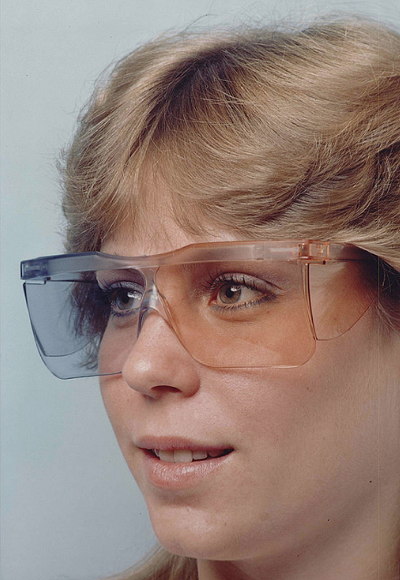
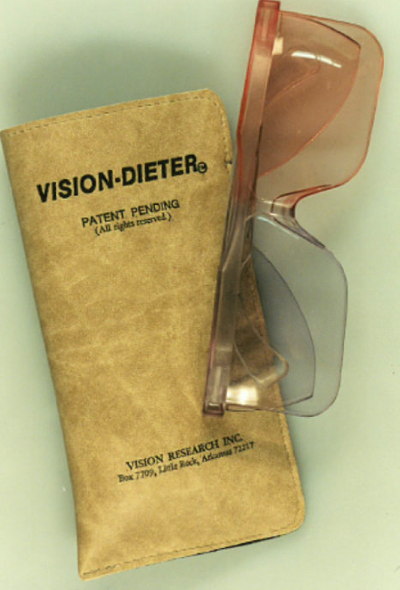
image source: Flickr
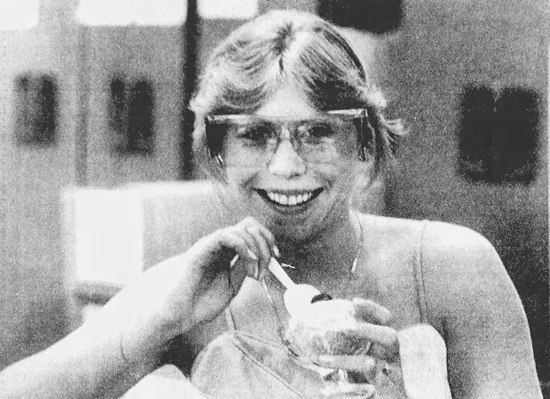
FDA employee Karen Kowlok models Vision-Dieter glasses
Newport News Daily Press - Mar 21, 1985
From the Wilmington News Journal - Aug 6, 1982:
Perhaps tinted eyeglasses could reverse the attraction to food by affecting the subconscious, Miller hypothesized. And he went to work.
The experiments began with employees of one of his enterprises, the Miller Vision Centers. Soon the research was extended to his patients.
At first, the results were mixed. He had chosen the wrong colors. Then he hit upon crimson brown and royal blue.
"It's crazy. I can't tell you exactly how, but it works," Miller said.
Soon testimonial letters were coming into Miller's office by the dozens. In virtually every case, people who wore the glasses said they weren't eating as much. He conducted control experiments with the help of a psychologist and claimed a 97 percent success rate.
Posted By: Alex - Thu Jun 29, 2017 -
Comments (1)
Category: Food, 1980s, Dieting and Weight Loss, Eyes and Vision
Eating Infinite Jest
Comedian Jamie Loftus recently posted a video commemorating the first year of her plan to eat an entire copy of the novel Infinite Jest by David Foster Wallace, one page at a time. She's never read it. She's just eating it.This caught my attention because, as it turns out, I've got a folder on my computer where I've been filing examples of people who eat books, aka bibliophagia.
I've already posted one of the examples here on WU. It was the case from 1926 of the boy who was eating his family's Bible.
Then there's a report from 1936 of a schoolboy who, in order to win a bet of 20 cents, ate all 138 pages of "The Mountain Garland," a dramatic poem by Petar Petrovic Njegos.
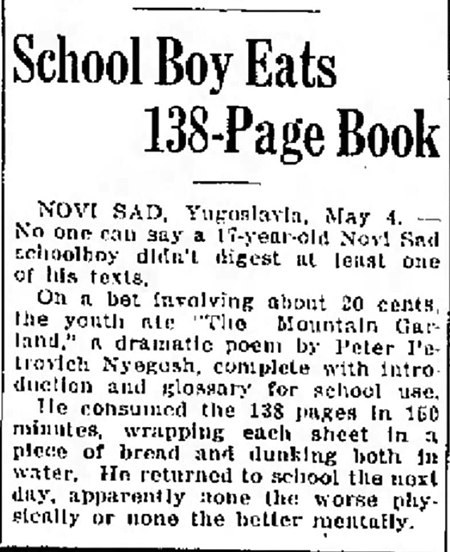
The Uniontown Morning Herald - May 5, 1936
And a bunch of examples can be found in The Excursions of a Book-Lover by Frederic Rowland Marvin:
A similar anecdote was related by Oelrich in his "Dissertation de Bibliothecarum et Librorum Fatis," (1756), of an Austrian general who had signed a note for two thousand florins, and was compelled by his creditor, when it fell due, to eat it.
A Scandinavian writer, the author of a political book, was compelled to choose between being beheaded or eating his manuscript boiled in broth.
Isaac Volmar, who wrote some spicy satires against Bernard, Duke of Saxony, was not allowed the courtesy of the kitchen, but was forced to swallow his literary productions uncooked.
Still worse was the fate of Philip Oldenburger, a jurist of great renown, who was condemned not only to eat a pamphlet of his writing, but also to be flogged during his repast, with orders that the flogging should not cease until he had swallowed the last crumb.
Posted By: Alex - Fri Jun 16, 2017 -
Comments (5)
Category: Food, Books
Recipes for Cooking Muskrat
How the U.S. Fish and Wildlife Service came to publish a muskrat meat cookbook: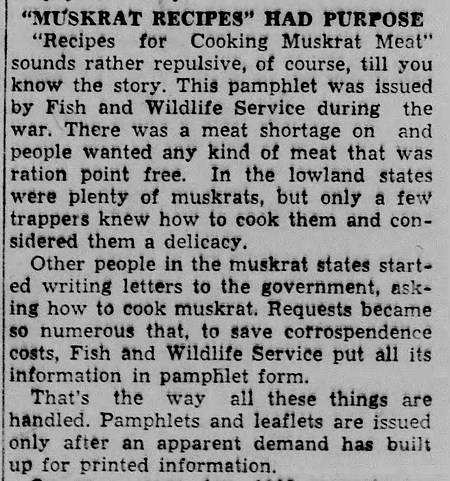
The Escanaba Daily Press - Mar 22, 1949
The recipes include Wine-fried Muskrat, Muskrat a la Terrapin, Maryland Shredded Muskrat, Muskrat Salad, Muskrat Pie, Pickled Muskrat, and Stewed Muskrat Liver. However, it doesn't include Cream of Muskrat Casserole, a delicacy that we posted about back in 2013.
You can read or download the full booklet at archive.org.
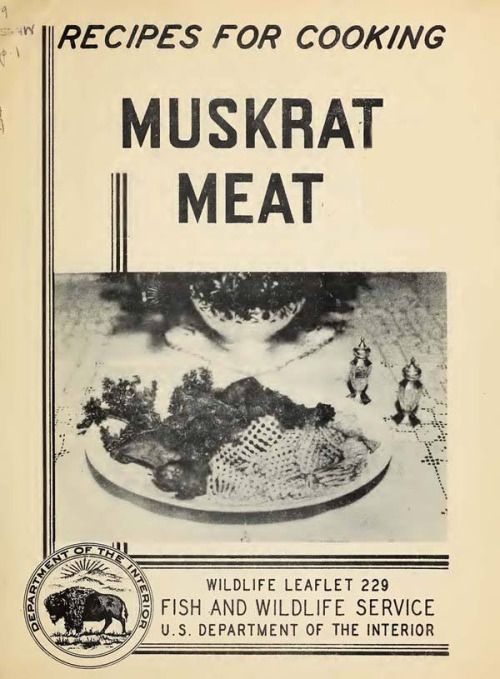
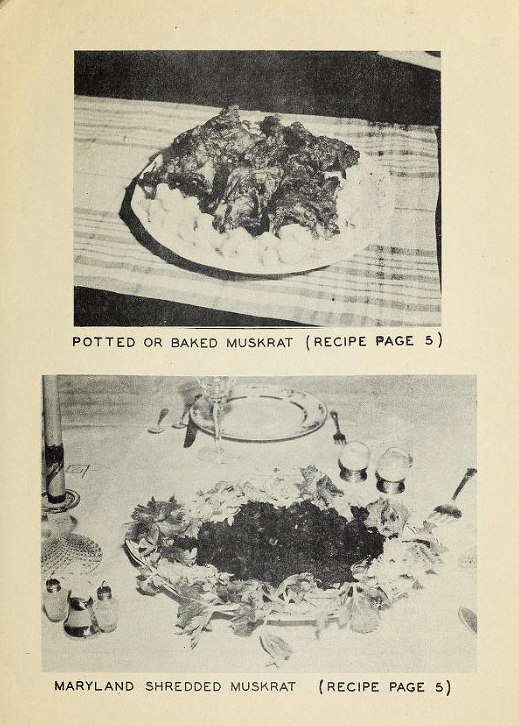

A muskrat - via wikipedia
Posted By: Alex - Thu Jun 15, 2017 -
Comments (4)
Category: Animals, Food, Cookbooks
The Mayonnaise diet
What exactly is the mayonnaise diet? Googling the term produces various vague references to such a thing, but no specifics. So, like the Dial-A-Dietitian, I have no idea what this diet involves... beyond a lot of mayonnaise and eggs.My guess is that it was either an alternative name for the Atkins Diet, or an eccentric variant of it, since the book Dr. Atkins' Diet Revolution first came out in 1972, which makes the timing about right for this person inquiring about a mayonnaise diet in 1974.
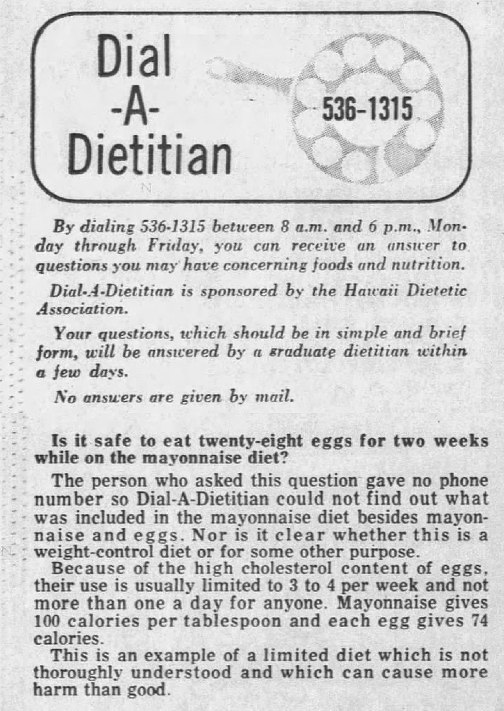
Honolulu Star Bulletin - June 19, 1974
Posted By: Alex - Tue Jun 13, 2017 -
Comments (3)
Category: Food, Mayonnaise, Dieting and Weight Loss
The Many Lives of the Borden’s Cows
Would today's media consumers accept bobbing paper cutouts in place of CGI?
Posted By: Paul - Sun Jun 04, 2017 -
Comments (1)
Category: Anthropomorphism, Business, Advertising, Products, Food, 1950s
Swift Pavilion, 1939 World’s Fair
The exhibition hall for Swift's was shaped like a giant hotdog.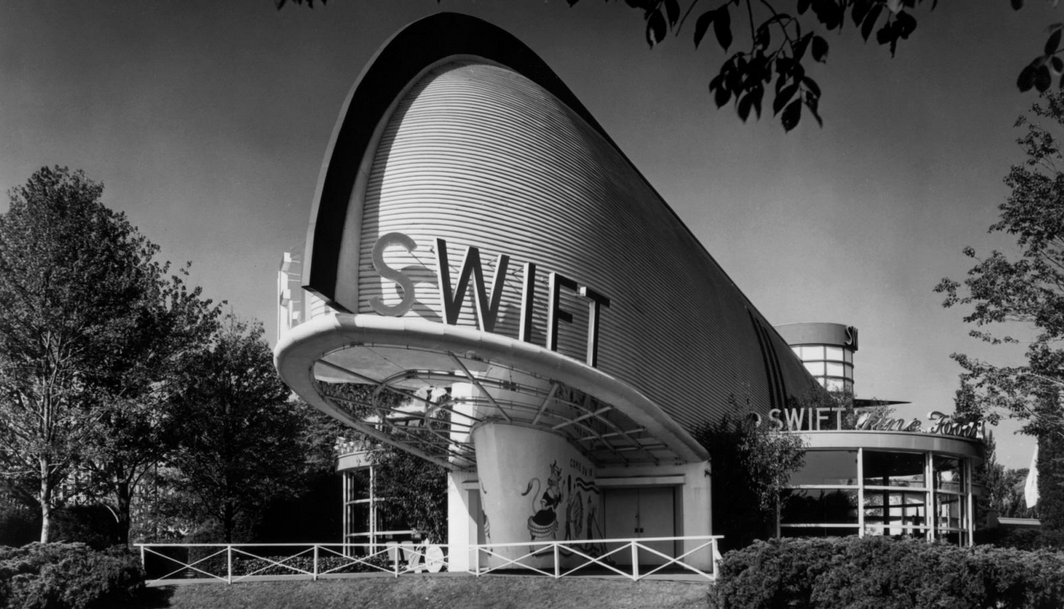
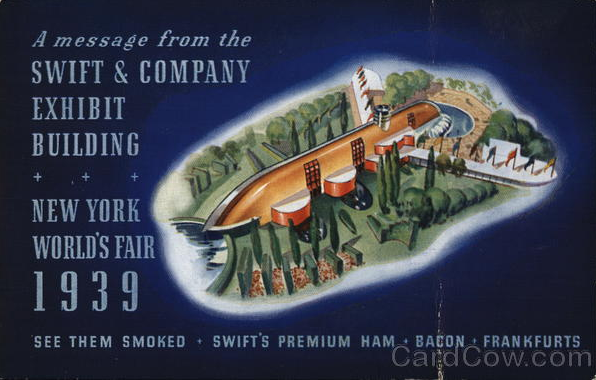


Posted By: Paul - Sat May 20, 2017 -
Comments (4)
Category: Architecture, Fairs, Amusement Parks, and Resorts, Food, 1930s

| Who We Are |
|---|
| Alex Boese Alex is the creator and curator of the Museum of Hoaxes. He's also the author of various weird, non-fiction, science-themed books such as Elephants on Acid and Psychedelic Apes. Paul Di Filippo Paul has been paid to put weird ideas into fictional form for over thirty years, in his career as a noted science fiction writer. He has recently begun blogging on many curious topics with three fellow writers at The Inferior 4+1. Contact Us |




